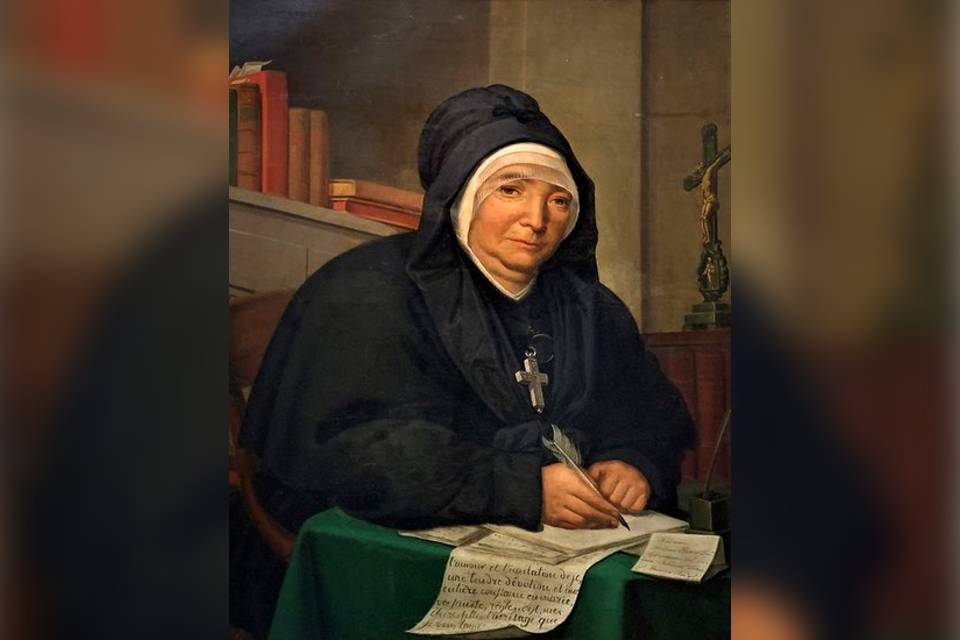
Who is Saint Marie Rivier?
Pope Pius IX called her ‘the Woman Apostle’ when he declared her as Venerable Marie Rivier. Pope John Paul II called her ‘a Prophet for our times’ during her Beatification on May 23, 1982. To the Sisters of the Presentation of Mary and to her spiritual family, she is simply Mother Rivier.
Marie Rivier was born on December 19, 1768, in the south of L’Ardèche, near Aubenas, in the village of Montpezat-sous-Bauzon, France. She is the third child of Marie-Anne Combe and Jean-Baptiste Rivier. On December 21, she was baptized in the church of Notre-Dame de Prévenchères. When she was sixteen months old, a fall from her parents’ bed fractured her femur, stunted her growth and prevented her from walking. Her mother, a woman of faith, entrusted ‘Marinette’ (Marie Rivier’s nickname) to Our Lady of Sorrows. Every day, she left the little girl at the foot of the Pietà, the sorrowful Mother holding her dead Son on Her lap. Each day, Marinette would say, “It is today that the Blessed Virgin will heal me.” The four years of her early life were spent in expectation of healing, contemplation, supplications and promises. On September 8, 1774, a Marian feast, she received her miraculous healing.
At the age of six, Marinette wanted to consecrate her life to God. This child yearned to share her experience of God by catechizing the children of the neighborhood. She awaited the time when she will fulfill the promise she made to Our Lady of Sorrows: “I will gather little children and teach them; I will tell them to serve you well.” In 1780, Marie left home to pursue her education at the boarding school run by the Sisters of Notre-Dame, in Pradelles (Haute-Loire). At seventeen years of age, she wished to become a religious in this congregation and thus requested entry to their novitiate. She was refused, because of her short stature and poor health. “Well, then,” she said, “since they don’t want me in the convent, I’ll found one myself.” Having returned to Montpezat in 1786, she opened a school. Despite the skepticism of many people, she remained steadfast. Marinette had exceptional gifts as a teacher and an educator in the faith. After her school in Montpezat was closed, Mademoiselle Rivier took the road on the slope of the Gravenne volcano and went to Thueyts where she opened a new school and eventually founded the Congregation of the Sisters of the Presentation of Mary on November 21, 1796.
It was a time when the existing congregations were disbanded and their members dispersed by the Revolution. During the Reign of Terror in France, when nobody would dare to call himself a Christian, Marie Rivier held secret Sunday assemblies and catechized not only children but their parents as well. Little by little, God sent qualified teachers to the young Congregation. Whenever the shortage of such teachers became too acute, Marie wrote to the Virgin Mary and placed her letters beneath the feet of her statues. Because of her filial trust in the Holy Mother of Jesus, she was never disappointed. When difficulties were overwhelming, Marie Rivier told her Sisters, “Our work stems wholly from God, and he does not want anything human in it—neither support nor the people’s praise.” In 1801, Monsieur Régis Vernet, confirmed Marie Rivier in her duties as superior. The foundress received the name Sister Anne-Marie.
Marie Rivier believed that without the family, the school cannot ensure a solid Christian formation. That is why she gathered the mothers of families and young women; the men came as well. She evangelized, exhorted, and catechized. She took the shepherding ministry of priests decimated by the Terror, and organized assemblies of prayer and Christian formation. Neighboring villages clamored for the Sisters to also come to them. Marie Rivier used to say: “Would that we had enough Sisters to make the Lord known and loved everywhere! I suffer ever more, knowing that so many parishes have no one to show them the way to heaven.”
In about twenty years, from 1796 to 1815, more than 150 schools were opened in L’Ardèche, and in nearby places in France. Soon, the first motherhouse in Thueyts became too small for the community. In 1819, the community moved to a very big house in Bourg-Saint-Andéol. She said: “If I had had money to undertake my foundations, I never would have been able to manage. Since I had nothing, I always thought that God would do everything.”
Despite her continuous poor health, Mother Rivier visited the foundations of the Congregation and established new ones, never compromising on the goal: “proclaiming Christ Jesus.” She welcomed orphans, and each time that the community experienced a more acute shortage of food, she welcomed one more orphan. Divine Providence never failed her. She watched over the formation of her sisters with the greatest care, a formation that consisted in “knowing Christ Jesus and living Christ Jesus in all his mysteries” throughout the liturgical year.
In 1822, Marie Rivier gave her daughters the Rule of Life, which was finally published. She told her Sisters: “We must be an open Gospel, a Gospel made clear to the entire world.” When she died, on February 3, 1838, more than 300 sisters were there to continue her work and to receive her final message: “I bequeath to you the spirit of prayer.”
Today, the Sisters of the Presentation of Mary are doing works of evangelization and charity in 21 countries together with the Marie Rivier Associates and the Presentation of Mary Consecrated Lay. As a marvel of zeal, prayer and faith, Marie Rivier is to be canonized by Pope Francis today, May 15, 2022 at 5:00 p.m. (Philippine time) in St. Peter’s Basilica, Rome, Italy.


No Comments